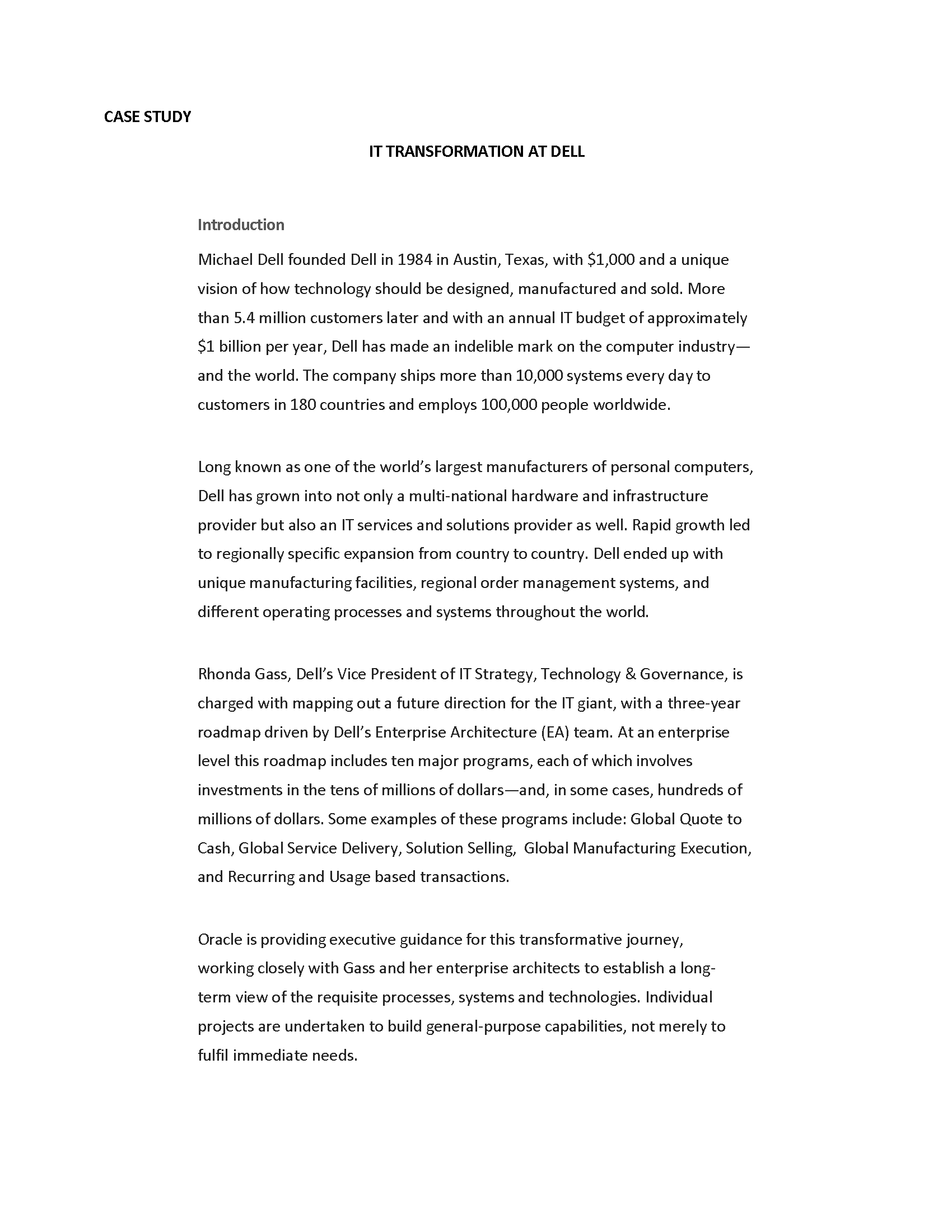
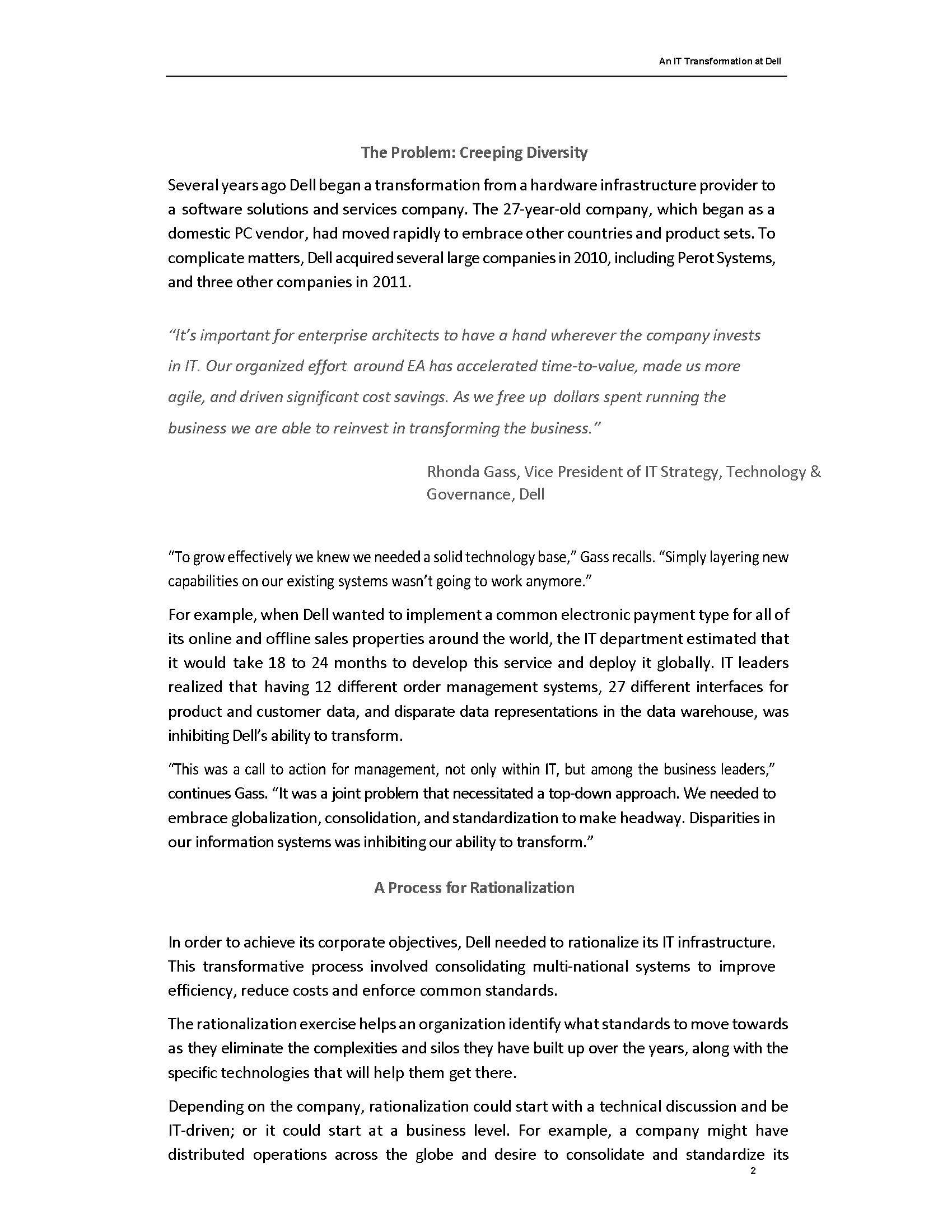
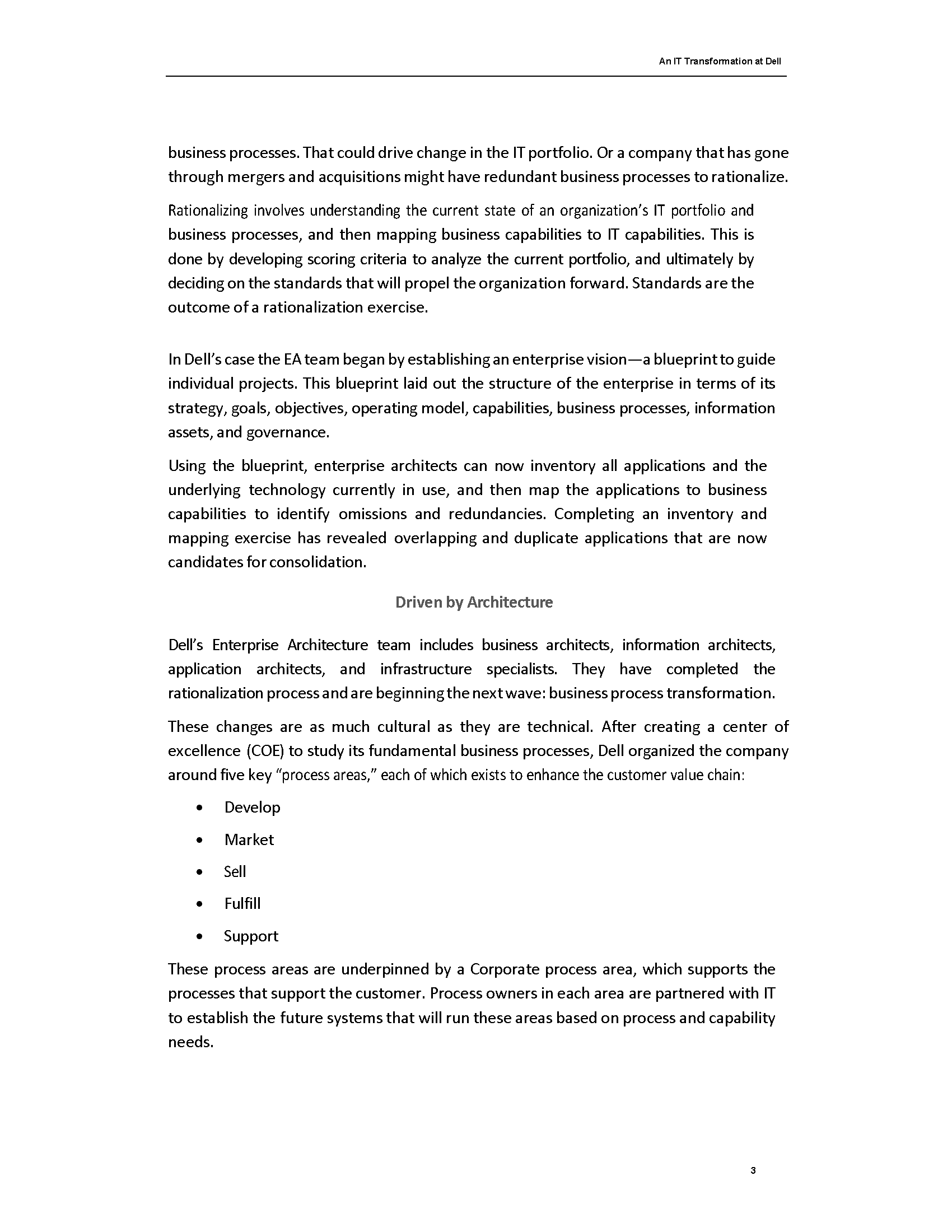
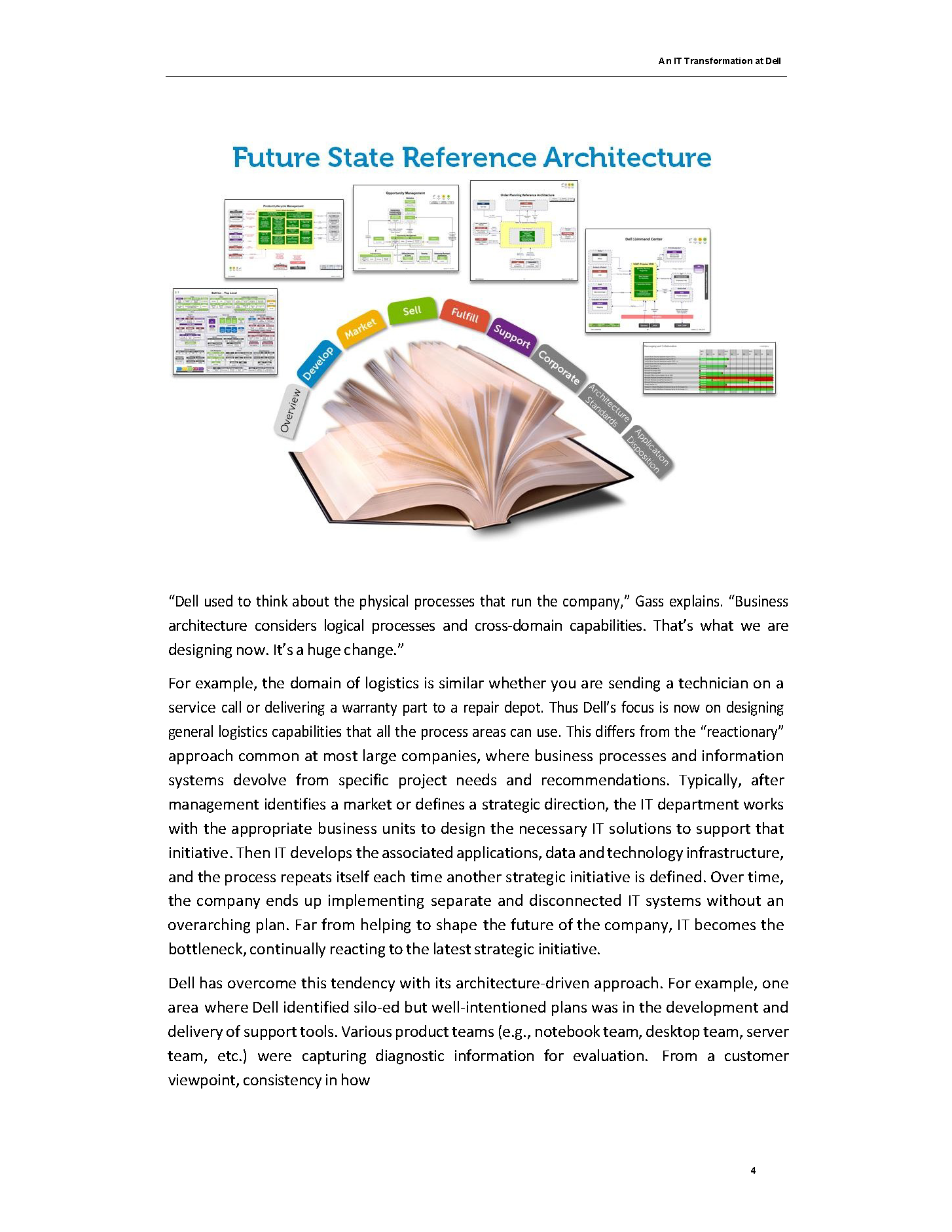

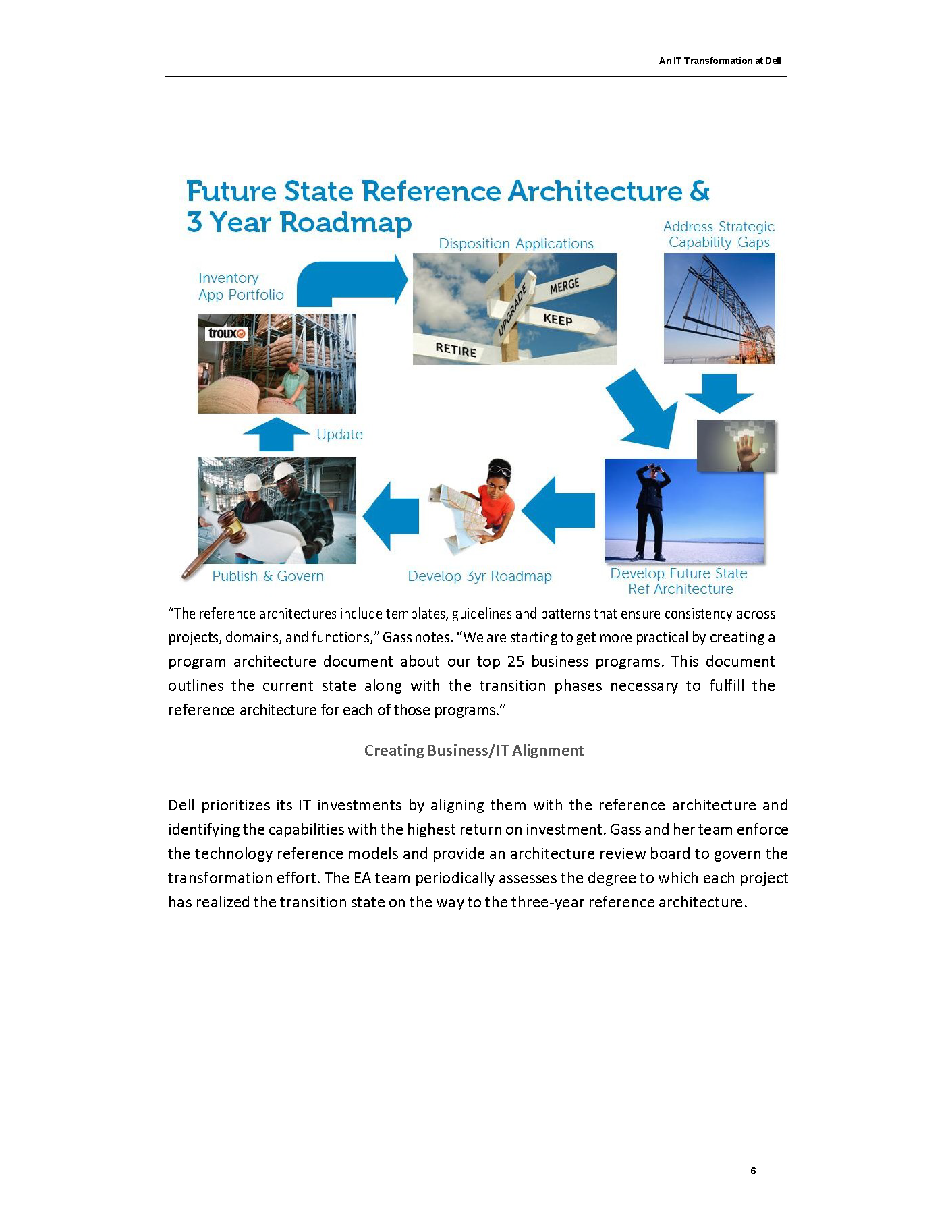
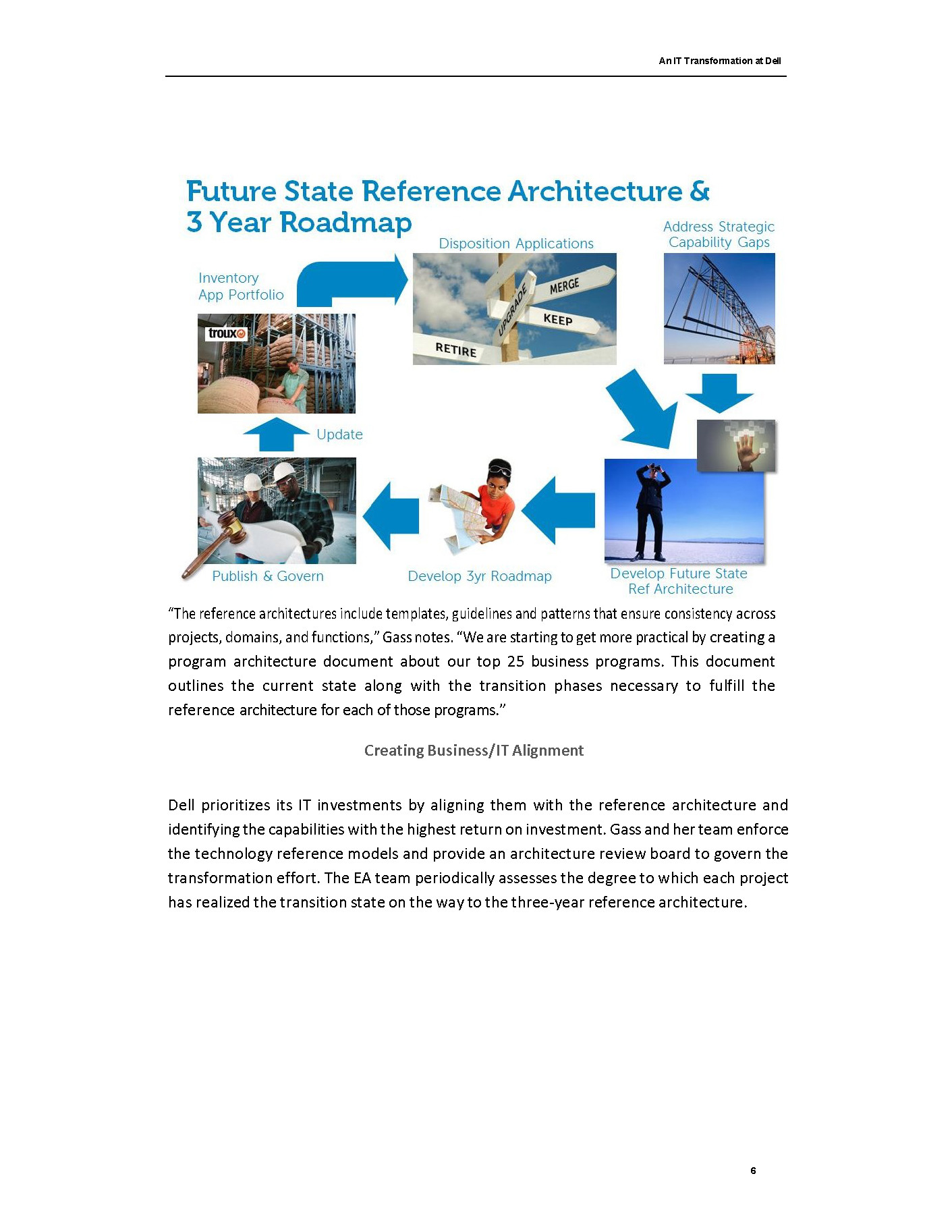
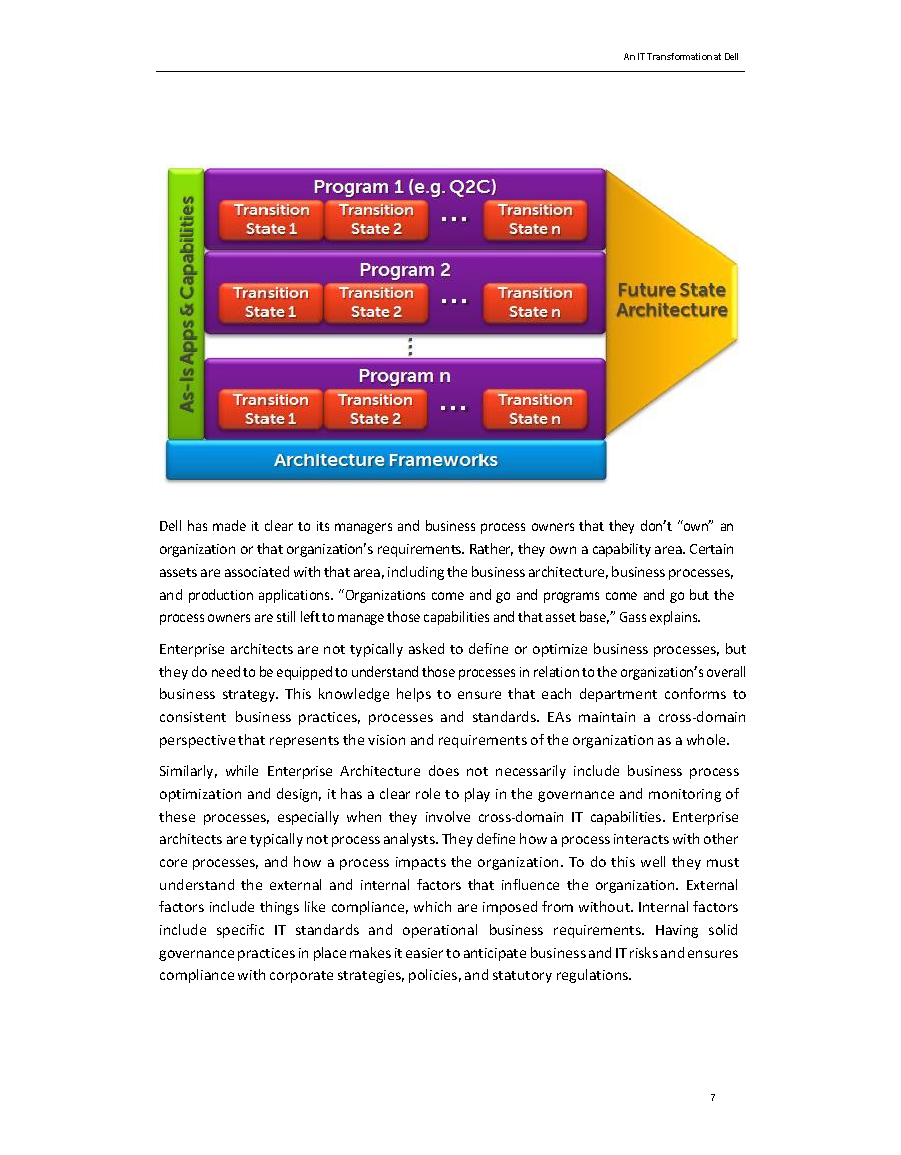

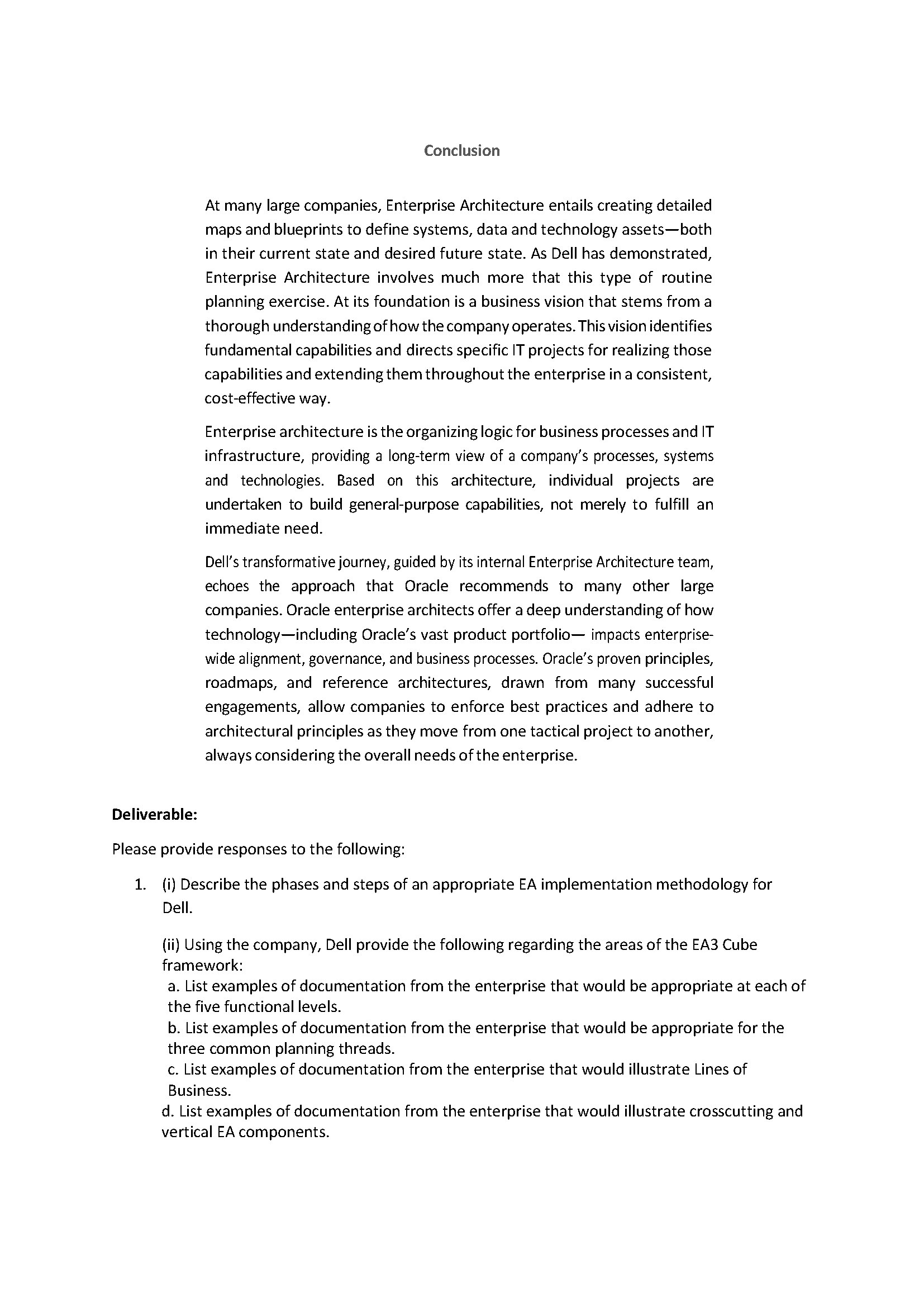

IT TRANSFORMATION AT DELL Introduction Michael Dell founded Dell in 1984 in Austin, Texas, with $1,000 and a unique vision of how technology should be designed, manufactured and sold. More than 5.4 million customers later and with an annual IT budget of approximately $1 billion per year, Dell has made an indelible mark on the computer industryand the world. The company ships more than 10,000 systems every day to customers in 180 countries and employs 100,000 people worldwide. Long known as one of the world's largest manufacturers of personal computers, Dell has grown into not only a multi-national hardware and infrastructure provider but also an IT services and solutions provider as well. Rapid growth led to regionally specific expansion from country to country. Dell ended up with unique manufacturing facilities, regional order management systems, and different operating processes and systems throughout the world. Rhonda Gass, Dell's Vice President of IT Strategy, Technology \& Governance, is charged with mapping out a future direction for the IT giant, with a three-year roadmap driven by Dell's Enterprise Architecture (EA) team. At an enterprise level this roadmap includes ten major programs, each of which involves investments in the tens of millions of dollars-and, in some cases, hundreds of millions of dollars. Some examples of these programs include: Global Quote to Cash, Global Service Delivery, Solution Selling, Global Manufacturing Execution, and Recurring and Usage based transactions. Oracle is providing executive guidance for this transformative journey, working closely with Gass and her enterprise architects to establish a longterm view of the requisite processes, systems and technologies. Individual projects are undertaken to build general-purpose capabilities, not merely to fulfil immediate needs. The Problem: Creeping Diversity Several years ago Dell began a transformation from a hardware infrastructure provider to a software solutions and services company. The 27-year-old company, which began as a domestic PC vendor, had moved rapidly to embrace other countries and product sets. To complicate matters, Dell acquired several large companies in 2010, including Perot Systems, and three other companies in 2011. "It's important for enterprise architects to have a hand wherever the company invests in IT. Our organized effort around EA has accelerated time-to-value, made us more agile, and driven significant cost savings. As we free up dollars spent running the business we are able to reinvest in transforming the business." Rhonda Gass, Vice President of IT Strategy, Technology \& Governance, Dell "To grow effectively we knew we needed a solid technology base," Gass recalls. "Simply layering new capabilities on our existing systems wasn't going to work anymore." For example, when Dell wanted to implement a common electronic payment type for all of its online and offline sales properties around the world, the IT department estimated that it would take 18 to 24 months to develop this service and deploy it globally. IT leaders realized that having 12 different order management systems, 27 different interfaces for product and customer data, and disparate data representations in the data warehouse, was inhibiting Dell's ability to transform. "This was a call to action for management, not only within IT, but among the business leaders," continues Gass. "It was a joint problem that necessitated a top-down approach. We needed to embrace globalization, consolidation, and standardization to make headway. Disparities in our information systems was inhibiting our ability to transform." A Process for Rationalization In order to achieve its corporate objectives, Dell needed to rationalize its IT infrastructure. This transformative process involved consolidating multi-national systems to improve efficiency, reduce costs and enforce common standards. The rationalization exercise helps an organization identify what standards to move towards as they eliminate the complexities and silos they have built up over the years, along with the specific technologies that will help them get there. Depending on the company, rationalization could start with a technical discussion and be IT-driven; or it could start at a business level. For example, a company might have distributed operations across the globe and desire to consolidate and standardize its An IT Transformation at Dell business processes. That could drive change in the IT portfolio. Or a company that has gone through mergers and acquisitions might have redundant business processes to rationalize. Rationalizing involves understanding the current state of an organization's IT portfolio and business processes, and then mapping business capabilities to IT capabilities. This is done by developing scoring criteria to analyze the current portfolio, and ultimately by deciding on the standards that will propel the organization forward. Standards are the outcome of a rationalization exercise. In Dell's case the EA team began by establishing an enterprise vision-a blueprint to guide individual projects. This blueprint laid out the structure of the enterprise in terms of its strategy, goals, objectives, operating model, capabilities, business processes, information assets, and governance. Using the blueprint, enterprise architects can now inventory all applications and the underlying technology currently in use, and then map the applications to business capabilities to identify omissions and redundancies. Completing an inventory and mapping exercise has revealed overlapping and duplicate applications that are now candidates for consolidation. Driven by Architecture Dell's Enterprise Architecture team includes business architects, information architects, application architects, and infrastructure specialists. They have completed the rationalization process and are beginning the next wave: business process transformation. These changes are as much cultural as they are technical. After creating a center of excellence (COE) to study its fundamental business processes, Dell organized the company around five key "process areas," each of which exists to enhance the customer value chain: - Develop - Market - Sell - Fulfill - Support These process areas are underpinned by a Corporate process area, which supports the processes that support the customer. Process owners in each area are partnered with IT to establish the future systems that will run these areas based on process and capability needs. 3 "Dell used to think about the physical processes that run the company," Gass explains. "Business architecture considers logical processes and cross-domain capabilities. That's what we are designing now. It's a huge change." For example, the domain of logistics is similar whether you are sending a technician on a service call or delivering a warranty part to a repair depot. Thus Dell's focus is now on designing general logistics capabilities that all the process areas can use. This differs from the "reactionary" approach common at most large companies, where business processes and information systems devolve from specific project needs and recommendations. Typically, after management identifies a market or defines a strategic direction, the IT department works with the appropriate business units to design the necessary IT solutions to support that initiative. Then IT develops the associated applications, data and technology infrastructure, and the process repeats itself each time another strategic initiative is defined. Over time, the company ends up implementing separate and disconnected IT systems without an overarching plan. Far from helping to shape the future of the company, IT becomes the bottleneck, continually reacting to the latest strategic initiative. Dell has overcome this tendency with its architecture-driven approach. For example, one area where Dell identified silo-ed but well-intentioned plans was in the development and delivery of support tools. Various product teams (e.g., notebook team, desktop team, server team, etc.) were capturing diagnostic information for evaluation. From a customer viewpoint, consistency in how An IT Transformation at Dell these capabilities are delivered is very important, leading Dell to think about its support to tools across all product lines and to use common develop/design and support processes. Gass believes that IT must lead the business in any type of large, transformative project. "The business doesn't always have the correct discipline or an established program management office, like IT does," she explains. "That's why business leaders rely on IT to solve problems that they haven't thought about. IT is the facilitator and IT can drive accountability in the business owners and help the various domains interlock." A Foundation for Execution Establishing business architecture involves capturing various "views" of the enterprise such as the business strategy, business capabilities, business processes, knowledge, and organization. In most EA projects, this information is used throughout the architecture development process to: - Identify business and IT "owners" to sponsor and participate in the architecture review and transformation process - Prioritize the areas in which to focus rationalization efforts - Capture business capabilities and business process insight - Eliminate redundancies and gaps in the applications portfolio - Align IT initiatives with business strategies and goals Dell has a systematic method for achieving these objectives. Every year its business architecture team sits down with the strategy planning office to review essential capabilities and complete a strategic plan. This plan typically focuses three to five years in the future. Gass and her team maintain a corporate-wide map of these capabilities that depicts specific business domains - what they call "process chevrons." This map provides a logical model of how Dell runs. The business architecture team looks for "capability gaps" and then interacts with the solution architecture team, the information architecture team, and the infrastructure team to fill those gaps. Dell's Enterprise Architecture team maintains a three-year reference architecture for each of these domains, which they update each quarter. "The reference architectures include templates, guidelines and patterns that ensure consistency across projects, domains, and functions," Gass notes. "We are starting to get more practical by creating a program architecture document about our top 25 business programs. This document outlines the current state along with the transition phases necessary to fulfill the reference architecture for each of those programs." Creating Business/IT Alignment Dell prioritizes its IT investments by aligning them with the reference architecture and identifying the capabilities with the highest return on investment. Gass and her team enforce the technology reference models and provide an architecture review board to govern the transformation effort. The EA team periodically assesses the degree to which each project has realized the transition state on the way to the three-year reference architecture. "The reference architectures include templates, guidelines and patterns that ensure consistency across projects, domains, and functions," Gass notes. "We are starting to get more practical by creating a program architecture document about our top 25 business programs. This document outlines the current state along with the transition phases necessary to fulfill the reference architecture for each of those programs." Creating Business/IT Alignment Dell prioritizes its IT investments by aligning them with the reference architecture and identifying the capabilities with the highest return on investment. Gass and her team enforce the technology reference models and provide an architecture review board to govern the transformation effort. The EA team periodically assesses the degree to which each project has realized the transition state on the way to the three-year reference architecture. Dell has made it clear to its managers and business process owners that they don't "own" an organization or that organization's requirements. Rather, they own a capability area. Certain assets are associated with that area, including the business ar chitecture, business processes, and production applitations. "Organizations come and go and prograns come and go but the process owners are still left to manage those capabilities and that asset base," Gass explains. Enterprise architects are not typically asked to define or optimize business processes, but they do need to be equipped to understand those processes in relation to the organization's overall business strategy. This knowledge helps to ensure that each department conforms to consistent business practices, processes and standards. EAs maintain a cross-domain perspective that represents the vision and requirements of the organization as a whole. Similarly, while Enterprise Architecture does not necessarily include business process optimization and design, it has a clear role to play in the governance and monitoring of these processes, especially when they involve cross-domain IT capabilities. Enterprise architects are typically not process an alysts. They define how a process interacts with other core processes, and how a process impacts the organization. To do this well they must understand the external and internal factors that influence the organization. External factors include things like compliance, which are imposed from without. Internal factors include specific IT standards and operational business requirements. Having solid governance practices in place makes it easier to anticipate business and IT risks and ensures compliance with corporate strategies, policies, and statutory regulations. Accounting for Costs When Dell decided to segment the company into four large business units, with senior executive VPs leading each division, full cost transparency for IT Services was a must. Gass says this has been a good way to get senior leaders involved in IT decisions. "Initially they didn't understand why certain things cost what they did and they questioned the value of IT. We had to be very precise about what things cost and why." Now these executives can see the specific cost drivers influencing their decisions. Each major business program has a finance controller acting as CFO ensuring the business results are being realized. A global audit team assesses each transformational program against risk areas at periodic milestones. "It's important for enterprise architects to have a hand wherever the company invests in IT," sums up Gass. "Our organized effort around EA has accelerated time-to-value, made us more agile, and driven significant cost savings. As we free up dollars spent running the business we are able to reinvest in transforming the business." At many large companies, Enterprise Architecture entails creating detailed maps and blueprints to define systems, data and technology assets-both in their current state and desired future state. As Dell has demonstrated, Enterprise Architecture involves much more that this type of routine planning exercise. At its foundation is a business vision that stems from a thorough understanding of how the company operates. This vision identifies fundamental capabilities and directs specific IT projects for realizing those capabilities and extending them throughout the enterprise in a consistent, cost-effective way. Enterprise architecture is the organizing logic for business processes and IT infrastructure, providing a long-term view of a company's processes, systems and technologies. Based on this architecture, individual projects are undertaken to build general-purpose capabilities, not merely to fulfill an immediate need. Dell's transformative journey, guided by its internal Enterprise Architecture team, echoes the approach that Oracle recommends to many other large companies. Oracle enterprise architects offer a deep understanding of how technology-including Oracle's vast product portfolio- impacts enterprisewide alignment, governance, and business processes. Oracle's proven principles, roadmaps, and reference architectures, drawn from many successful engagements, allow companies to enforce best practices and adhere to architectural principles as they move from one tactical project to another, always considering the overall needs of the enterprise. Deliverable: Please provide responses to the following: 1. (i) Describe the phases and steps of an appropriate EA implementation methodology for Dell. (ii) Using the company, Dell provide the following regarding the areas of the EA3 Cube framework: a. List examples of documentation from the enterprise that would be appropriate at each of the five functional levels. b. List examples of documentation from the enterprise that would be appropriate for the three common planning threads. c. List examples of documentation from the enterprise that would illustrate Lines of Business. d. List examples of documentation from the enterprise that would illustrate crosscutting and vertical EA components. (iii) Obtain the Annual Report of Dell and list potential EA components at each level of the EA3 Framework. IT TRANSFORMATION AT DELL Introduction Michael Dell founded Dell in 1984 in Austin, Texas, with $1,000 and a unique vision of how technology should be designed, manufactured and sold. More than 5.4 million customers later and with an annual IT budget of approximately $1 billion per year, Dell has made an indelible mark on the computer industryand the world. The company ships more than 10,000 systems every day to customers in 180 countries and employs 100,000 people worldwide. Long known as one of the world's largest manufacturers of personal computers, Dell has grown into not only a multi-national hardware and infrastructure provider but also an IT services and solutions provider as well. Rapid growth led to regionally specific expansion from country to country. Dell ended up with unique manufacturing facilities, regional order management systems, and different operating processes and systems throughout the world. Rhonda Gass, Dell's Vice President of IT Strategy, Technology \& Governance, is charged with mapping out a future direction for the IT giant, with a three-year roadmap driven by Dell's Enterprise Architecture (EA) team. At an enterprise level this roadmap includes ten major programs, each of which involves investments in the tens of millions of dollars-and, in some cases, hundreds of millions of dollars. Some examples of these programs include: Global Quote to Cash, Global Service Delivery, Solution Selling, Global Manufacturing Execution, and Recurring and Usage based transactions. Oracle is providing executive guidance for this transformative journey, working closely with Gass and her enterprise architects to establish a longterm view of the requisite processes, systems and technologies. Individual projects are undertaken to build general-purpose capabilities, not merely to fulfil immediate needs. The Problem: Creeping Diversity Several years ago Dell began a transformation from a hardware infrastructure provider to a software solutions and services company. The 27-year-old company, which began as a domestic PC vendor, had moved rapidly to embrace other countries and product sets. To complicate matters, Dell acquired several large companies in 2010, including Perot Systems, and three other companies in 2011. "It's important for enterprise architects to have a hand wherever the company invests in IT. Our organized effort around EA has accelerated time-to-value, made us more agile, and driven significant cost savings. As we free up dollars spent running the business we are able to reinvest in transforming the business." Rhonda Gass, Vice President of IT Strategy, Technology \& Governance, Dell "To grow effectively we knew we needed a solid technology base," Gass recalls. "Simply layering new capabilities on our existing systems wasn't going to work anymore." For example, when Dell wanted to implement a common electronic payment type for all of its online and offline sales properties around the world, the IT department estimated that it would take 18 to 24 months to develop this service and deploy it globally. IT leaders realized that having 12 different order management systems, 27 different interfaces for product and customer data, and disparate data representations in the data warehouse, was inhibiting Dell's ability to transform. "This was a call to action for management, not only within IT, but among the business leaders," continues Gass. "It was a joint problem that necessitated a top-down approach. We needed to embrace globalization, consolidation, and standardization to make headway. Disparities in our information systems was inhibiting our ability to transform." A Process for Rationalization In order to achieve its corporate objectives, Dell needed to rationalize its IT infrastructure. This transformative process involved consolidating multi-national systems to improve efficiency, reduce costs and enforce common standards. The rationalization exercise helps an organization identify what standards to move towards as they eliminate the complexities and silos they have built up over the years, along with the specific technologies that will help them get there. Depending on the company, rationalization could start with a technical discussion and be IT-driven; or it could start at a business level. For example, a company might have distributed operations across the globe and desire to consolidate and standardize its An IT Transformation at Dell business processes. That could drive change in the IT portfolio. Or a company that has gone through mergers and acquisitions might have redundant business processes to rationalize. Rationalizing involves understanding the current state of an organization's IT portfolio and business processes, and then mapping business capabilities to IT capabilities. This is done by developing scoring criteria to analyze the current portfolio, and ultimately by deciding on the standards that will propel the organization forward. Standards are the outcome of a rationalization exercise. In Dell's case the EA team began by establishing an enterprise vision-a blueprint to guide individual projects. This blueprint laid out the structure of the enterprise in terms of its strategy, goals, objectives, operating model, capabilities, business processes, information assets, and governance. Using the blueprint, enterprise architects can now inventory all applications and the underlying technology currently in use, and then map the applications to business capabilities to identify omissions and redundancies. Completing an inventory and mapping exercise has revealed overlapping and duplicate applications that are now candidates for consolidation. Driven by Architecture Dell's Enterprise Architecture team includes business architects, information architects, application architects, and infrastructure specialists. They have completed the rationalization process and are beginning the next wave: business process transformation. These changes are as much cultural as they are technical. After creating a center of excellence (COE) to study its fundamental business processes, Dell organized the company around five key "process areas," each of which exists to enhance the customer value chain: - Develop - Market - Sell - Fulfill - Support These process areas are underpinned by a Corporate process area, which supports the processes that support the customer. Process owners in each area are partnered with IT to establish the future systems that will run these areas based on process and capability needs. 3 "Dell used to think about the physical processes that run the company," Gass explains. "Business architecture considers logical processes and cross-domain capabilities. That's what we are designing now. It's a huge change." For example, the domain of logistics is similar whether you are sending a technician on a service call or delivering a warranty part to a repair depot. Thus Dell's focus is now on designing general logistics capabilities that all the process areas can use. This differs from the "reactionary" approach common at most large companies, where business processes and information systems devolve from specific project needs and recommendations. Typically, after management identifies a market or defines a strategic direction, the IT department works with the appropriate business units to design the necessary IT solutions to support that initiative. Then IT develops the associated applications, data and technology infrastructure, and the process repeats itself each time another strategic initiative is defined. Over time, the company ends up implementing separate and disconnected IT systems without an overarching plan. Far from helping to shape the future of the company, IT becomes the bottleneck, continually reacting to the latest strategic initiative. Dell has overcome this tendency with its architecture-driven approach. For example, one area where Dell identified silo-ed but well-intentioned plans was in the development and delivery of support tools. Various product teams (e.g., notebook team, desktop team, server team, etc.) were capturing diagnostic information for evaluation. From a customer viewpoint, consistency in how An IT Transformation at Dell these capabilities are delivered is very important, leading Dell to think about its support to tools across all product lines and to use common develop/design and support processes. Gass believes that IT must lead the business in any type of large, transformative project. "The business doesn't always have the correct discipline or an established program management office, like IT does," she explains. "That's why business leaders rely on IT to solve problems that they haven't thought about. IT is the facilitator and IT can drive accountability in the business owners and help the various domains interlock." A Foundation for Execution Establishing business architecture involves capturing various "views" of the enterprise such as the business strategy, business capabilities, business processes, knowledge, and organization. In most EA projects, this information is used throughout the architecture development process to: - Identify business and IT "owners" to sponsor and participate in the architecture review and transformation process - Prioritize the areas in which to focus rationalization efforts - Capture business capabilities and business process insight - Eliminate redundancies and gaps in the applications portfolio - Align IT initiatives with business strategies and goals Dell has a systematic method for achieving these objectives. Every year its business architecture team sits down with the strategy planning office to review essential capabilities and complete a strategic plan. This plan typically focuses three to five years in the future. Gass and her team maintain a corporate-wide map of these capabilities that depicts specific business domains - what they call "process chevrons." This map provides a logical model of how Dell runs. The business architecture team looks for "capability gaps" and then interacts with the solution architecture team, the information architecture team, and the infrastructure team to fill those gaps. Dell's Enterprise Architecture team maintains a three-year reference architecture for each of these domains, which they update each quarter. "The reference architectures include templates, guidelines and patterns that ensure consistency across projects, domains, and functions," Gass notes. "We are starting to get more practical by creating a program architecture document about our top 25 business programs. This document outlines the current state along with the transition phases necessary to fulfill the reference architecture for each of those programs." Creating Business/IT Alignment Dell prioritizes its IT investments by aligning them with the reference architecture and identifying the capabilities with the highest return on investment. Gass and her team enforce the technology reference models and provide an architecture review board to govern the transformation effort. The EA team periodically assesses the degree to which each project has realized the transition state on the way to the three-year reference architecture. "The reference architectures include templates, guidelines and patterns that ensure consistency across projects, domains, and functions," Gass notes. "We are starting to get more practical by creating a program architecture document about our top 25 business programs. This document outlines the current state along with the transition phases necessary to fulfill the reference architecture for each of those programs." Creating Business/IT Alignment Dell prioritizes its IT investments by aligning them with the reference architecture and identifying the capabilities with the highest return on investment. Gass and her team enforce the technology reference models and provide an architecture review board to govern the transformation effort. The EA team periodically assesses the degree to which each project has realized the transition state on the way to the three-year reference architecture. Dell has made it clear to its managers and business process owners that they don't "own" an organization or that organization's requirements. Rather, they own a capability area. Certain assets are associated with that area, including the business ar chitecture, business processes, and production applitations. "Organizations come and go and prograns come and go but the process owners are still left to manage those capabilities and that asset base," Gass explains. Enterprise architects are not typically asked to define or optimize business processes, but they do need to be equipped to understand those processes in relation to the organization's overall business strategy. This knowledge helps to ensure that each department conforms to consistent business practices, processes and standards. EAs maintain a cross-domain perspective that represents the vision and requirements of the organization as a whole. Similarly, while Enterprise Architecture does not necessarily include business process optimization and design, it has a clear role to play in the governance and monitoring of these processes, especially when they involve cross-domain IT capabilities. Enterprise architects are typically not process an alysts. They define how a process interacts with other core processes, and how a process impacts the organization. To do this well they must understand the external and internal factors that influence the organization. External factors include things like compliance, which are imposed from without. Internal factors include specific IT standards and operational business requirements. Having solid governance practices in place makes it easier to anticipate business and IT risks and ensures compliance with corporate strategies, policies, and statutory regulations. Accounting for Costs When Dell decided to segment the company into four large business units, with senior executive VPs leading each division, full cost transparency for IT Services was a must. Gass says this has been a good way to get senior leaders involved in IT decisions. "Initially they didn't understand why certain things cost what they did and they questioned the value of IT. We had to be very precise about what things cost and why." Now these executives can see the specific cost drivers influencing their decisions. Each major business program has a finance controller acting as CFO ensuring the business results are being realized. A global audit team assesses each transformational program against risk areas at periodic milestones. "It's important for enterprise architects to have a hand wherever the company invests in IT," sums up Gass. "Our organized effort around EA has accelerated time-to-value, made us more agile, and driven significant cost savings. As we free up dollars spent running the business we are able to reinvest in transforming the business." At many large companies, Enterprise Architecture entails creating detailed maps and blueprints to define systems, data and technology assets-both in their current state and desired future state. As Dell has demonstrated, Enterprise Architecture involves much more that this type of routine planning exercise. At its foundation is a business vision that stems from a thorough understanding of how the company operates. This vision identifies fundamental capabilities and directs specific IT projects for realizing those capabilities and extending them throughout the enterprise in a consistent, cost-effective way. Enterprise architecture is the organizing logic for business processes and IT infrastructure, providing a long-term view of a company's processes, systems and technologies. Based on this architecture, individual projects are undertaken to build general-purpose capabilities, not merely to fulfill an immediate need. Dell's transformative journey, guided by its internal Enterprise Architecture team, echoes the approach that Oracle recommends to many other large companies. Oracle enterprise architects offer a deep understanding of how technology-including Oracle's vast product portfolio- impacts enterprisewide alignment, governance, and business processes. Oracle's proven principles, roadmaps, and reference architectures, drawn from many successful engagements, allow companies to enforce best practices and adhere to architectural principles as they move from one tactical project to another, always considering the overall needs of the enterprise. Deliverable: Please provide responses to the following: 1. (i) Describe the phases and steps of an appropriate EA implementation methodology for Dell. (ii) Using the company, Dell provide the following regarding the areas of the EA3 Cube framework: a. List examples of documentation from the enterprise that would be appropriate at each of the five functional levels. b. List examples of documentation from the enterprise that would be appropriate for the three common planning threads. c. List examples of documentation from the enterprise that would illustrate Lines of Business. d. List examples of documentation from the enterprise that would illustrate crosscutting and vertical EA components. (iii) Obtain the Annual Report of Dell and list potential EA components at each level of the EA3 Framework

















